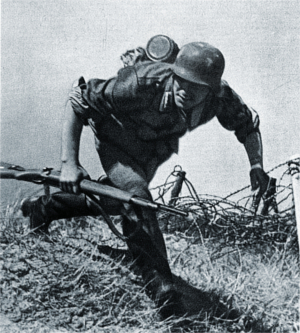Pictured: Camp Djelfa.
Quoting Susan Slyomovics in The Holocaust and North Africa, pages 103–106:
German reparation protocols presumed that the 1942 Allied landing and liberation of North Africa, an operation in which the Algerian Jewish resistance fighters network played an outsized rôle on the ground,25 included the reinstatement of French nationality for Algerian Jews and the closing of internment camps. This did not happen in the military, among the last French institutions in Algeria to abolish racial discrimination against Algerian Jews and reintegrate them as French citizens into combat units.
Thus in March 1942, Bedeau camp detainees discovered that their liberation was not at hand. Rather, new bureaucratic devices reclassified and integrated them into the groupement de travailleurs algériens (GTA), a grouping of Algerian civilian workers already established in 1940 under the decree of November 23, 1940. The camp was placed under the direct authority of the Direction d’Économie Algérienne of the General Government of Algeria, seemingly removing camp inmates from military authority.
This next phase made them subservient to a new civilian organization, one founded in 1942 and emanating directly from the Vichy government: the Service d’Ordre Légionnaire (SOL), a precursor to Vichy’s dreaded collaborationist paramilitary Milice. Bedeau camp authorities were “Legionnaires,” a term unrelated to the French Foreign Legion. The Legionnaires were anti‐Jewish fascist units whose oversight of the camps signaled the next demeaning and confusing phase of prolonged internment.26
It is specifically during this phase of the GTA that disagreements emerge about whether Bedeau had taken on the form of a concentration camp, a designation that postwar Germany’s reparation protocols and France’s Ministry of Defense both rejected. In contrast, a contemporary undated report on Bedeau pointed to degraded material conditions and psychological abuse.
From the political and moral viewpoint: impression of a concentration camp, fights with civilians of Bedeau, insults by those in charge and by the Foreign Legion, with the themes: dirty [insert slur here], dirty crows. NOTE.—This stage marked an indelible imprint on Camp Bedeau; despite all the notes and all the orders, the Camp remains today under a kind of spell of petty‐mindedness and inferiority from which neither leaders nor men can rid themselves.27
The anonymous reporter describes a cordoned‐off domain under a malevolent spell, an irrational sphere in which Algerian Jewish soldiers were relegated to civilian status, overseen by anti‐Semitic authorities, both civilian and military, and hidden away in the remote reaches of southern Algeria, far from the central authority command’s ability to break the spell of mistreatment that the Allied landing should have lifted.
[…]
One caption states that the demeaning black outfits of internment were not imposed in Bedeau. After becoming civilian “Jewish workers” (travailleurs israélites), Bedeau camp inmates were subjected to new regulations that officially prohibited them from wearing military outfits, but these seem not to have been enforced; instead, housing, food, and the reported black outfits (hence the disparaging nickname corbeaux, or “crows”) were supposedly furnished by the military but charged to workers through salary deductions.
[…]
In addition, the Bedeau detainees were routinely loaned out as manual labor to European settlers for agricultural work during harvests or to the nearby Bossuet internment camp, or they were sent to do forestry work and trench digging. The photographs in Bel Ange’s book remind viewers that a camera was available, and the images, staged outdoors, show posed groups, which makes it unclear who determined what to photograph.
All images paradoxically are entirely positive in content, with groups of smiling young suntanned soldiers busily at their tasks, thereby occulting why they were there, who they were, and what they were doing.31
December 1942–May 1943:
Jewish Pioneer Battalions to Camp DissolutionIn December 1942, as the French army began mobilizing for the invasions of [Vichy] France and [Fascist] Italy, those Jewish workers inducted into the GTIs, or groupes de travailleurs israélites, were switched back to quasi‐military status from civilian control and reclassed as bataillons de pionniers israélites (BPIs, or Jewish pioneer battalions). Reattached to the French army but as mere auxiliary work units, the detainees were reattired officially in military uniforms.
In addition, they were encouraged to volunteer for combat units, but only as indigènes, or “natives,” in the infantry, because they still could not claim French nationality. Some did so to leave Bedeau and demonstrate their patriotism but fell into the trap of volunteering for worse conditions in the nearby Magenta camp.
Most refused native status made available by joining Algerian Muslim units, whose food and housing conditions were known to be substandard and insalubrious. They also justifiably feared the loss of previous military ranking and time in the service, which was indeed confirmed in the postwar decades.
BPI status, or for that matter any worker unit status, did not entitle them to veterans benefits, nor could they attain the appellation of “political detainee,” which France’s Ministry of Defense in 2003 denied to BPI units because, as the ministry argued, when the units were created, Vichy […] was no more.32
The double humiliation of Vichy orders—to exclude Jews from the military and to force them into work units in detention camps—remained deliberately in place in post‐Vichy […] Algeria, historical facts denied by the French military command to this day. Nor should the rôle of American forces be discounted; the […] Vichy‐oriented administration in Algeria remained unchanged and the anti‐Semitism of the authorities continued under the Allied forces.
(Emphasis added in most cases.)
Click here for events that happened today (April 17).
1941: The NDH passed the ‘Law for the Defense of the People’. Likewise, the Kingdom of Yugoslavia formally surrendered to the Third Reich as Foreign Minister Cincar‐Marcovic signed the armistice with Axis representatives in Belgrade. The Wehrmacht captured Yugoslavian destroyers Beograd and Dubrovnik at Kotor, but destroyer Zagreb was scuttled by her crew (with two dying in the process). Aside from that, SS‐Untersturmfuehrer Maximilian Grabner at Auschwitz announced that urns containing the ashes of Polish political prisoners who died at Auschwitz no longer needed to be sent to their families. Axis infantry and tanks attacked Tobruk, Libya in the early afternoon, but became repulsed. After dark, twelve Axis tanks engaged Allied counterparts along the line; three Axis tanks were destroyed.

